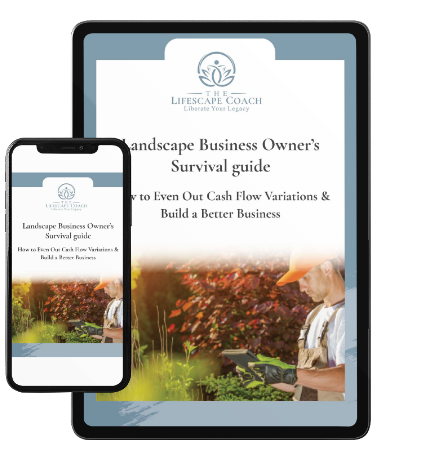4 Strategic Steps to Recruiting and Retaining a Quality Landscape Team
In fact, how to hire good employees is one of the top three major issues I hear about over and over again from other landscape business owners in my coaching practice. Hiring in the landscape industry often tends to be a knee-jerk reaction to an immediate need for working hands. This has been made even worse by the pandemic.
Some business owners exacerbate the problem with a “dump and run” business model, hiring a team and then putting them to work with little to no support. No training, no process, no guiding documentation, no quality control. Just a hope and a prayer that the new workers know what they’re doing and understand what needs to be done. This, of course, is the perfect playbook for failure.
What type of landscape team should you build?
Conventional wisdom would tell you to start with skills when hiring – does the candidate have the appropriate skill set for the position? But that would be wrong. Skills can be taught. To build a solid team from the ground up, with every team member pulling in the same direction, you need to start with attitude and character traits. Do the prospective employee’s values align with yours as the business owner and with your company’s mission? Does the prospect really want to be a part of your team, to learn and grow, to accept responsibility, and be accountable? If they do, that’s the foundation of an ideal landscape team.
All of this distills down into two powerful words that define how you do business, how employees and clients view your business, and how successful you will be: Company Culture!

Cultivating a compassionate culture in your business
As a landscape business owner with over 35 years in the business, I know that our employees are more important than any truck, piece of equipment, or account. Without them, we cannot hope to reach our business growth goals and achieve real success. Yet many landscape business owners treat their employees almost as an afterthought. This creates a disconnect between employer and employee, leaving workers feeling ignored and disrespected. As a result, morale suffers, productivity falls off, and your business stagnates. Is that any way to build a successful company?
The answer lies in basic human psychology. As a species, humans are built to live and work in a community. It’s crucial for a successful community, whether it’s a society or a business, to experience and promote compassion. Learning to listen, consider, and engage with team members fosters positive change and will make the significant difference between running a status quo, stale business, and developing a vibrant business of possibility and innovation. The single most important thing you can do is create a compassionate culture that fosters psychological safety.
Encourage your team members to speak up when there’s an issue that concerns them. Listen to their requests; communicate clearly, openly, and often. Stay ahead of situations to prevent them from becoming problems. Show more appreciation and approval. Let your team know that you see them, appreciate them as a group and that they have value as individuals and as key components of your company’s success. Do not confuse this with being a pushover or a softy. Rather see this as the foundation of strong leadership. People will go to the mat for a leader that conveys a clear mission and a set of values that they are aligned with.
Here are four tips that can help you create a compassionate culture for your organization:
- Practice “non-attachment”. Most business owners have their own way of doing things – that’s why many start their own businesses. Over time, it’s easy to grow attached to doing things your way and resist any suggestion of change. This can make it difficult to grow your business. Instead, practice “non-attachment” – disengaging from the “my way or the highway” approach – and open up to new ideas and options you might not have considered otherwise. Being willing to adopt new concepts and strategies offers opportunities for meeting your goals faster, more successfully, and with longer-lasting results.
- Don’t wait until there’s a crisis. Small businesses can suffer from the distraction and disruption of always “putting out fires.” That’s often because there’s only one person at the helm, responsible for all decisions and actions. With proper training, support, and encouragement, other team members can be equipped to step up and are often glad to accept the extra responsibility to help resolve situations and issues before they become major problems.
- Reap the benefits of rewards. Team members respond more positively and with greater effort when they’re rewarded. That doesn’t always mean showering them with extra cash. It means leading conversations with what’s going on that’s right, not wrong, offering public kudos for a job well done, and doing that little something extra, such as buying pizza for everyone or throwing a company barbeque as a sign of appreciation for all they do. A little reward will go a long way.
- Practice consistency. Having a clear operational focus and an easily-followed set of guidelines for how to engage internally and externally is the best way to stay consistently on the road to success. This starts with everyone knowing WHAT you do, WHY you do what you do, and HOW you do it. When everyone has a clear, consistent picture of what your business is all about and the role the entire team plays, your ability to succeed increases exponentially.
Finding and retaining top landscape industry talent
There’s an old saying, “You can’t find good help these days,” that for many in the green industry seems to be especially true. The triple whammy of a dropping unemployment rate, sharply rising wages, and a generally smaller pool of qualified individuals makes the hiring challenge for landscape companies even greater.
Add the post-pandemic element of fear on top of that trifecta and you have a seemingly impossible mountain to climb. What is going to make your company stand out as a place where someone wants to work?
It starts with shifting your mindset from “hunting” for workers to “attracting” perfect fit employees. That starts with creating a “job value proposition” because you’re not just hiring an employee, you’re creating an asset for your company. Today’s job-seekers want to know, “WIIFM” (what’s in it for me) and it’s up to you to tell them.
Think of it this way: it’s the POSITION that creates value for your business, it’s the PERSON who fills it that optimizes that value. What does this position bring to the party in terms of building value and revenue for your landscape company? Once you’re clear on that, you’ll have a better understanding of exactly the kind of individual you need to successfully fill that position and how filling that position will use their talent, spark their passion, and offer them personal and professional meaning.
Without offering the proper employment incentive to prospects you run the risk of creating a mismatched team that is less reliable, efficient, and productive than you’d like. It’s not enough to have an attractive compensation package; you need to have an “investment strategy” in place as well – a structured plan to invest in your workers’ personal and professional development and a way to establish clear and consistent communications so they feel their input and contribution to the company is valued.

Here are five tips for creating a positive, pro-active work environment that will help you attract and retain the best talent for your team:
- Engage with every team member to get the most out of each individual and optimize team performance. Favoritism hurts them and your business
- Meet one-on-one with employees three times a year to discuss their experiences working for your company -- what works for them and what doesn’t. Learn what motivates them. Remember: YOU don’t have to do all the one on ones, if you have managers… they can help with this.
- Build skills to help employees feel more confident and be more productive -- it also benefits the company by minimizing work delays. Skill-building doesn’t have to be some monumental project; sometimes simply providing a little knowledge will go a long way toward improving performance.
- Share aspirations by openly discussing goals with employees to help build support and boost chances for success. Sharing aspirations encourages participation by the entire team and builds motivation for all.
- Now go ahead and do it -- most of us did not get into the landscape business to manage people. However, when you sign up to be an owner and you hire people, you’re in the people management business, whether you like it or not.
As you attract quality people with this strategy, provide a clear path for advancement, create some benchmarks for promotion, and identify metrics to measure employee advancement. Good people are always looking to grow, and while that looks different for each individual, you’ll need to set out a clearly-defined process for achieving that growth that will encourage them. Sometimes growth is less of an “up the ladder advancement” and more of a lateral expansion of what they already do. Knowing what’s appropriate means you have to be actively listening and asking questions.
Invest in ALL of your employees
Every business seems to have one or two employees who stand out. They’re the ones who show up early and stay late. They’re focused on doing the best job possible and are always looking for ways to improve. These are the employees that landscape business owners and managers gravitate toward, encouraging them, and focusing their attention on these superstars because they’re the ones visibly helping the company succeed.
But your success is not all about them. It’s about your entire team.
Sooner or later, every employee leaves, including the superstars. And when they do, you’re stuck. The successful strategy is to spread the love and attention to ALL of your team members – superstars and second-stringers alike. Identify the unofficial roles your employees play so you can develop a team with strong leadership and equally strong support. Start by focusing on these three distinct categories of employees:
- Leaders: who’s in charge and minding the mission, stepping up when something needs to be decided or done?
- Structural players: who are the less-visible workers getting the actual work done?
- Supporters: who are the employees more comfortable with following through, following up, and taking care of the details that ensure the job is done right and the client is happy?
While a superstar may get all the glory, the B-players are the real backbone of your workforce. They like a work plan, guidance, and predictability. They prefer a strong team and management around them to do that upper-tier work that they perceive as the “hard stuff.” But with the proper investment of time and effort in their development and training, they are very likely to be the source of your next A-player, your up-and-coming superstar.

Achieving the right balance produces the right team
One of the great lessons being learned by employers during the pandemic is that money isn’t everything to employees. In fact, money ranks farther down than many business owners might think. Workplace culture, a positive work environment, salary transparency, position development, and simple respect rank higher. It bears repeating: workers want, more than anything else, to be valued and respected.
Attracting and retaining the best workers requires a fine blend of competitive compensation, a compassionate company culture, flexible working conditions, clear and consistent working guidelines, and engaged management. If this means restructuring your business model, then you need to strongly consider doing that. Yes, you may take a temporary revenue or profit hit, but it will be the foundation to truly soar and scale operations so you can blast through your financial goals in the near future.
Yes, the pandemic has certainly presented a host of challenges to landscape business owners. But it’s also presented opportunities. This is your chance to take a more positive, proactive approach with a can-do attitude that will attract can-do employees.
Are you ready to create a dream team to take your business to the next level?
If you’re serious about growth and ready for change, then schedule a Landscape Business Coaching Discovery Session with me today! In this no-obligation, high-impact call we’ll uncover the first big rock that you’ve got to move to get this process of team building underway so you can make great hiring decisions this year!
Landscape Business Owners Survival Guide



